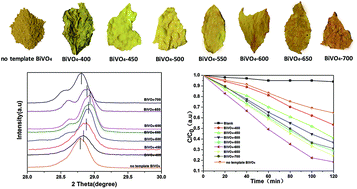In situ synthesis of C-doped BiVO4 with natural leaf as a template under different calcination temperatures†
Abstract
In this work, a series of C-doped BiVO4 (BiVO4-T) with natural leaf structures were synthesized by a dipping-calcination method with the leaf of Chongyang wood seedling as a template under different calcination temperatures. The structures and morphologies of BiVO4-T were observed by FE-SEM observations. The doped carbon in BiVO4-T was formed in situ from the natural leaf during the calcination process and the amount of doping could be regulated from 0.51–1.16 wt% by controlling the calcination temperature. It was found that the sample calcined at 600 °C (BiVO4-600) with a C-doping content of 1.16 wt% showed the best photocatalytic degradation activity. After 120 min visible light irradiation, the photocatalytic decomposition efficiency of RhB for BiVO4-600 is 2.2 times higher than that of no template BiVO4. The enhanced photocatalytic performance is ascribed to the combined action of the unique morphology and doped-carbon. It is considered that the unique structures and carbon doping of BiVO4-600 are in favor of the enhancement of visible light absorption, which was supported by UV-vis DRS. Furthermore, the C-doping can enhance the efficient separation and transfer of the photo-generated electron–hole pairs, as proved by PL measurements. This study provides a simple dipping-calcination method and found the best calcination temperature to fabricate a high-performance BiVO4, which simultaneously achieves morphology and C-doping control in one step.



 Please wait while we load your content...
Please wait while we load your content...